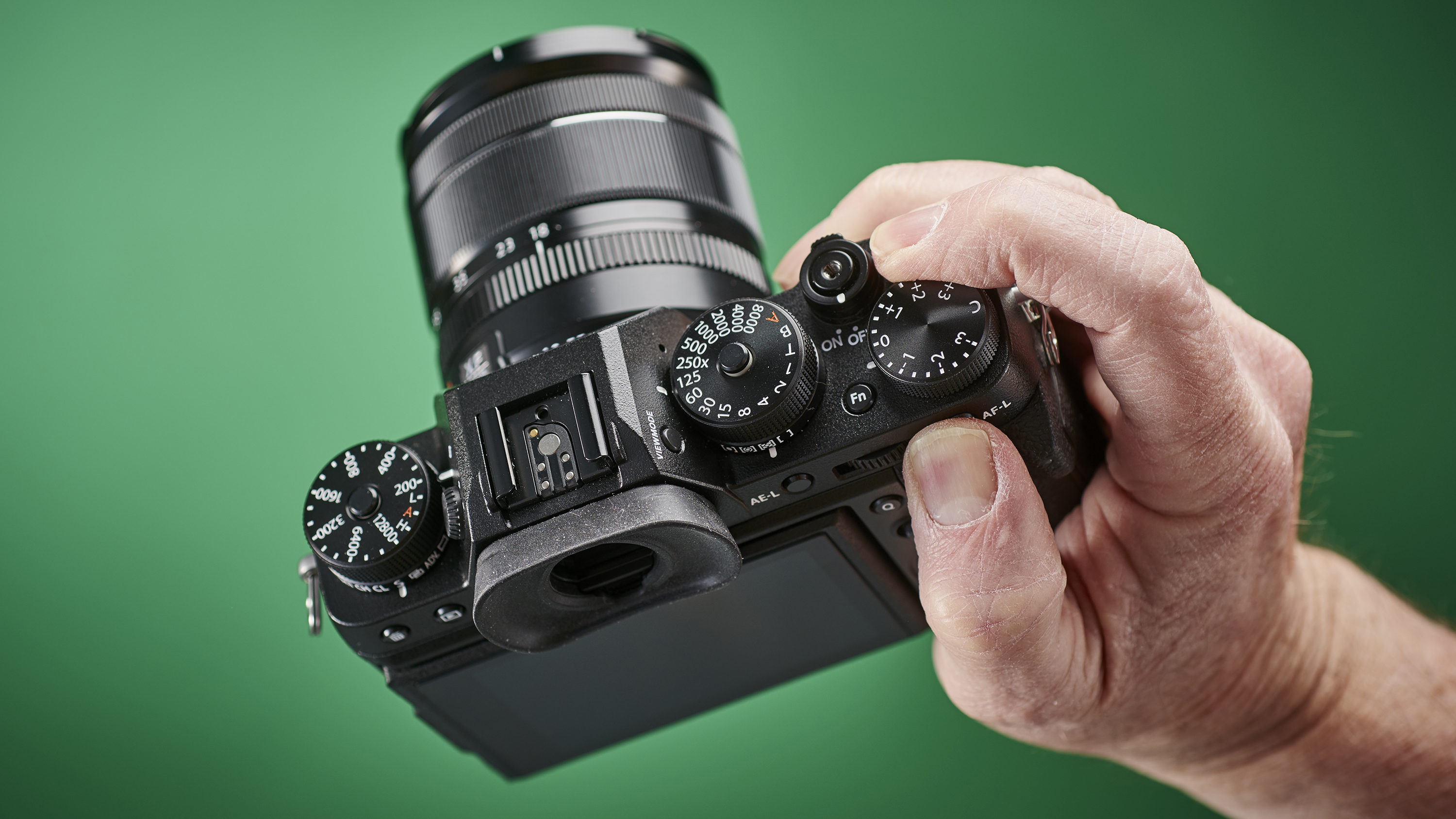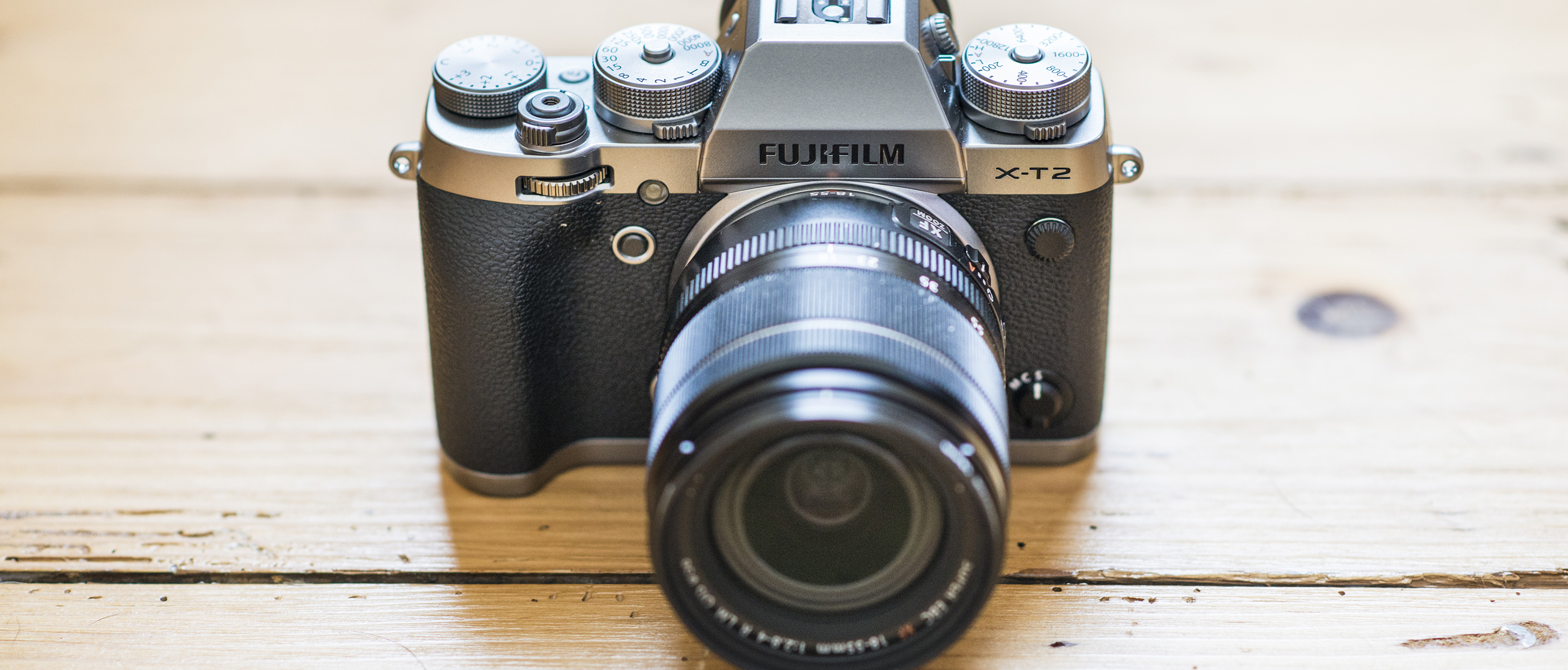Why you can trust TechRadar
Build and handling
- Magnesium alloy construction
- Dust and weather-sealed
- Weighs 507g
As we saw with the X-Pro2, rather than opting for a radical new design with the second-generation model, Fujifilm has elected to take the X-T1 as its starting point, refining and tweaking elements of that design to arrive at what promises to be an even more polished camera.

As before, the body is crafted from magnesium alloy, providing a solid and durable feel in the hand. The body also is weather-sealed at 63 points to protect the camera from dust and moisture, so when it's partnered with one of the growing number of WR (weather-resistant) Fujinon lenses you'll have a setup that's very well protected from the elements.
If you've got a keen eye, you'll notice that the ISO and shutter speed dials have been heightened slightly compared to the X-T1, while the dial locks that divided opinion on the X-T1 have been adapted, making it now possible to toggle each dial's setting without the need to release the lock, should you wish.


This is certainly a welcome improvement, and reduces the frustration when trying to quickly change settings as the camera is raised to your eye, though it still feels slightly awkward when setting the ISO like this – and would be nice to see the option to set a function button to quickly adjust ISO.
The exposure compensation dial has also been tweaked, so as well as offering physical adjustments of up to ±3EV in 1/3 increments, there's now a C position to set compensation up to ±5EV using the camera's front command dial. This works very well – even if you're using the command dial to set aperture, simply press it to swap over to exposure compensation adjustment.
The X-T2 does away with a dedicated video button, instead having the setting amongst the drive modes, the thinking being that rather than simply using the X-T2 to capture the odd short video, Fujifilm wants us to see video as a more sophisticated, dedicated mode on the camera – more on that in a bit.
Fujifilm has also raised the 4-way buttons and, as we saw with the X-Pro2, the X-T2 gets the benefit of a multi-directional focus lever that the thumb can rest on, making it a much quicker process to select the desired focus area.
Sign up for breaking news, reviews, opinion, top tech deals, and more.
It really is a nice camera to pick up and shoot with
The level of customisation is impressive as well, allowing you to tailor the X-T2 to your own specific shooting style. There are six dedicated function buttons (including the 4-way buttons), plus the AE-L and AF-L buttons, with each of these allowing you to assign a plethora of settings in the X-T2's menu.
Other little tweaks include a larger eye cup for more comfortable viewfinder shooting, locks on both the card cover and battery compartment, and a slightly enlarged handgrip and rear thumb rest.
These last two additions make the X-T2 that bit more comfortable when hand-holding, with the overall feel of the X-T2 just that bit nicer than the X-T1. It really is a nice camera to pick up and shoot with, with the grip further enhancing the experience, though this obviously makes the camera that bit larger.
Autofocus
- 169-point AF
- Eye Detection AF
- 5 AF-C presets, plus custom option
One of the obstacles for a lot of mirrorless cameras to get over is the skepticism towards AF performance. Perhaps not so much for static subjects, but in the main it's always been felt that when it comes to moving subjects, mirrorless can't match the speed and sophistication of some more advanced DSLR systems.
The X-T1 had a solid if rather unremarkable AF system which saw a fairly major firmware upgrade to boost AF performance, but it still didn't really satisfy the needs of those shooting fast-moving subjects.
With the new system in the X-T2, Fujifilm not only feels that it's improved the basic AF performance compared X-T1, it believes it's made huge strides when it comes to continuous AF and subject tracking.
The hybrid AF system employs both phase-detection and contrast-detection points, with up to 169 phase detect points arranged in a large square formation (13 x 13) in the centre, supplemented by two grids of 6 x 13 contrast detect points either size to deliver a total of 325 focusing points across a large area of the frame.
That's for single point AF; for Zone and Wide/Tracking this drops to a still impressive 91-point arrangement, this time with a central grid of 7 x 7 phase detect points, with the edges of the frame handled by two grids of 3 x 7 contrast detect points. Users can swap to this arrangement for single point AF too if they wish.
While the X-Pro2 featured a wealth of improvements to the performance in Continuous AF mode, the X-T2 goes even further. Fuji has overhauled the AF algorithm to boost accuracy, as well as allowing you to fine-tune how the camera reacts to the way your subject moves in the frame, how fast it moves, and where in the frame the camera places bias for focusing.
These three parameters are known Tracking Sensitivity (how long the camera waits before switching focus), Speed Tracking Sensitivity (determines how sensitive the tracking system is to changes in subject speed) and Zone Area Switching (whether bias is in the centre, auto or front), with the X-T2 featuring five presets (similar to what we've seen with some high-end Canon DSLRs), as well as a custom setting allowing you to tinker with the three variables yourself.
AF is nice and quick, while the level of sophistication when it comes to tracking is impressive, making the X-T1 look very pedestrian indeed. We trialled it on fast-moving cars using Preset 3 (Accelerating / decelerating subjects) and coupled with the improved frequency of the AF search timing, reduced from 280m/secs on the X-T1 to just 114m/secs on the X-T2, it rarely missed a beat.
All in all then we'd have to say that in use the AF performance is a huge leap forward. Whereas in the past we'd have hesitated to pick up an X-series camera with the express intention of shooting action, we'd have no concerns now thanks to the very grown-up and capable AF system in the X-T2.
Current page: Build, handling and AF
Prev Page Introduction and key features Next Page Performance and image quality
Phil Hall is an experienced writer and editor having worked on some of the largest photography magazines in the UK, and now edit the photography channel of TechRadar, the UK's biggest tech website and one of the largest in the world. He has also worked on numerous commercial projects, including working with manufacturers like Nikon and Fujifilm on bespoke printed and online camera guides, as well as writing technique blogs and copy for the John Lewis Technology guide.



